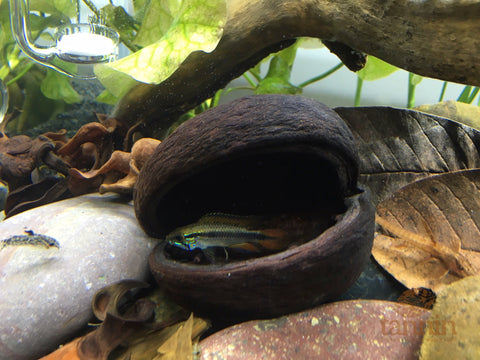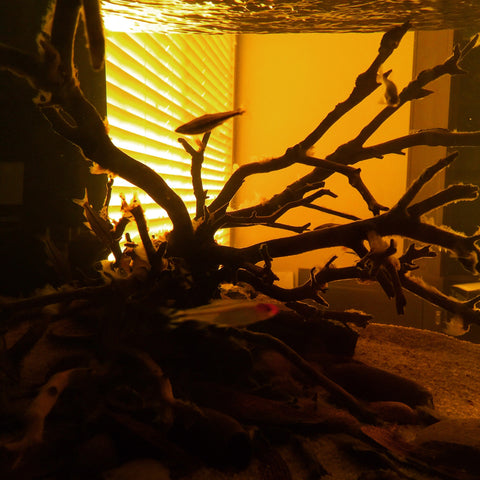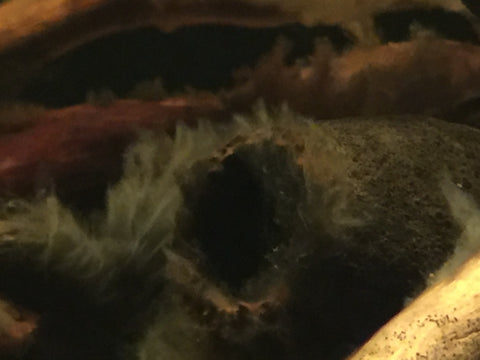- Continue Shopping
- Your Cart is Empty
Expectations.
We have written a lot about the "mental shift" that we need to make as quarts when embracing this type of more natural "New Botanical"-style system. It's simply NOT the pristine, "uber-white-sand-and-scrupulously-clean-well-manicured-planted" 'scapes we've been indoctrinated to accept as "natural" over the past decade or two. It's not some sterile-looking artistic representation of nature. (not that there is ANYTHING wrong with that, of course, but I believe that the term "natural" is a slight overstepping of this definition).
Rather, the truly "natural" aquarium embraces the transitions and processes that occur when you introduce terrestrial materials into the aquatic environment, both to the materials themselves, and to the aquatic environment. This is exactly what has happened for eons in the rivers, streams, and lakes of the world.

There are, of course, expectations that we've developed from a century of looking at aquarium a certain way. Indeed, the "New Botanical"-style aquarium offers a different set of expectations, and those of us who have worked with these types of aquariums have come to expect some things from our aquariums. We know, for example, that these aquariums will create a very different aesthetic, with a completely different set of activities. Any of the following aesthetic influences can be expected to occur as a result of incorporating these materials into our displays:
Brown Water- The result of tannins being released by botanical materials interacting with the water.
Decomposing Leaves- Caused by microorganisms within the aquarium, resulting in the gradual breakdown of the tissues.
Algal Growth- Resulting from an influx of botanical materials providing some nutrients and a "substrate" upon which they may grow. These are typically minimal and transient.
Biofilms- Surface accumulations of harmless sugars and bacteria which tend to occur on submerged botanical materials as the interact with the aquatic environment.
Change- A "New Botanical"-style aquarium is in a constant transition; it's hardly a static environment, as the process of decomposition, growth, and recycling of nutrients creates a dynamic physical and aesthetic environment within the aquarium.

The hardest part of working with this type of aquarium is accepting the fact that these processes and their accompanying aesthetics are normal, predictable, and in most cases, beneficial for the animals which reside in the aquarium. When we have an understanding of what is going to occur, we can then simply enjoy the dynamics of this type of system.
As we've said many times in this blog, these types of systems are not "set and forget", in that you need to monitor water chemistry, be prepared to remove detritus and materials which you feel are aesthetically problematic, or are causing any environmental issues which you feel are detrimental to your livestock (very rare).

Understanding that many fishes and invertebrates actually utilize the botanicals, decomposing leaves, biofilms, and micro-and microorganisms which inhabit them as supplemental foods sources, or forage among them, just like they do in nature, is the key. Sure, you can have botanicals in a system and keep it near pristine. I've done this many times, as have many other hobbyists: You brush the seed pods and such regularly to remove/discourage growth of the biofilms and algae that may be present. You siphon out leaves as they start to break down, and replace them with fresh ones. You can even avoid having the "tint" in your water if you desire through continuous use of chemical filtration media (such as activated carbon, Purigen, Poly Filter, and the like).

There are many ways to successfully manage this type of aquarium from a physical standpoint.

There is only one way to manage a "New Botanical"-style aquarium from a mental standpoint, and that's to accept the dynamics, understand what they are, and how they are beneficial to the animals residing in the system...and appreciating the changes as they occur within the aquarium.

It's a true mental shift. An acceptance of the transient nature of botanical materials in an aquatic environment. An appreciation for the positive impact that they have, and the beauty they convey.
Expectations are truly important. And the understanding of WHAT to expect is equally, if not more, important.
Stay curious. Stay open-minded.
And Stay Wet.
Scott Fellman
Tannin Aquatics













Scott Fellman
Author